
The Koolhoven F.K.58 was a single engine, interceptor-fighter aircraft designed and mainly manufactured by N V Koolhoven in the Netherlands under contract by France. Intended for Armée de l'Air use, the F.K.58 saw limited service in the Battle of France.

The BAT F.K.26 was a British single-engined four-passenger biplane transport aircraft produced by British Aerial Transport Company Limited of London at the end of World War I.

The BAT F.K.28 Crow was a British single-seat ultralight aircraft produced by British Aerial Transport Company Limited of London. It was intended to be the "aerial equivalent of the motor cycle".
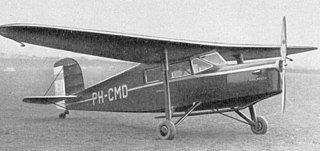
The Koolhoven F.K.43 was a small four-seat, single-engined monoplane passenger aircraft manufactured by Koolhoven in the Netherlands. It was a direct successor of the F.K.41.

The Koolhoven F.K.51 was a 1930s Dutch two-seat basic training biplane built by the Koolhoven Company.
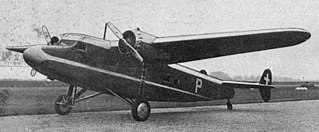
The Koolhoven F.K.50 was a 1930s Dutch eight-passenger light transport monoplane designed and built by Koolhoven.
The Fike Model D was a light aircraft built in the United States in the early 1950s. Designed by airline pilot William Fike, it was a conventional high-wing strut-braced monoplane with tailskid undercarriage and seating for one or two people in an enclosed cabin. In appearance, the aircraft strongly resembled a Piper Cub, with only the tail surfaces sourced from one. An unusual feature was that the flight controls were mounted to the ceiling of the cabin, rather than the floor. This facilitated the folding or removal of the seat or seats to enable the aircraft's use as a sleeping space when camping with it. Plans were marketed for homebuilding.

The PZL-102 Kos (blackbird) is a Polish two-seat touring and training monoplane designed and built by PZL.

The Focke-Wulf A 20 Habicht was an airliner developed in Germany in the late 1920s. It was a high-wing cantilever monoplane with fixed tailskid undercarriage. The fuselage was deep and seated four passengers in a fully enclosed cabin. The type was not bought by the airlines and only a few examples were built.

The Koolhoven F.K.42 was a parasol-wing, two-seat training monoplane manufactured by Koolhoven in the Netherlands. Only one was built.
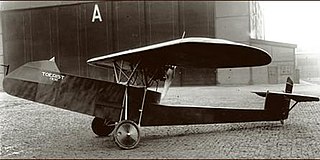
The Koolhoven F.K.30 Toerist was a small sport aircraft built in the Netherlands in 1927, intended for use by aeroclubs. The fuselage carried the pilot and one passenger in tandem in a bathtub-like open cockpit. The cantilever parasol wing was mounted above and behind them, with the main wheels of the fixed undercarriage directly below the wing, at the sides of the fuselage. The engine, driving a pusher propeller, was mounted on the aircraft centerline at the aft portion of the wing. The conventional empennage was carried on a boom extending below the propeller arc. The wing, including engine, was designed so that it could be pivoted 90° while on the ground, allowing the aircraft to be stored and transported more easily.
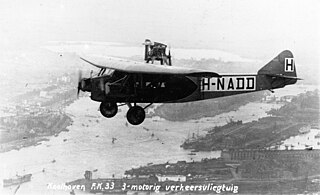
The NVI F.K.33 was an airliner built in the Netherlands in 1925 for use by KLM for night flying.
The Koolhoven F.K.40 was a small airliner built in the Netherlands in 1928 for KLM Royal Dutch Airlines. It was a conventional high-wing cantilever monoplane powered by a single engine in the nose. The fuselage was made of welded steel tube construction with a wooden wing skinned in plywood and held in place by four bolts to facilitate removal. The cabin was spacious for an aircraft of its size, and was intended to be readily reconfigured for passengers, mail, or freight. Although up to six seats could be fitted, the only F.K.40 built flew with four.
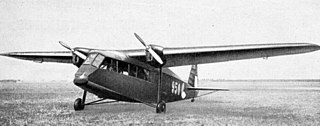
The Koolhoven F.K.49 was a photographic survey aircraft built in the Netherlands in 1935.
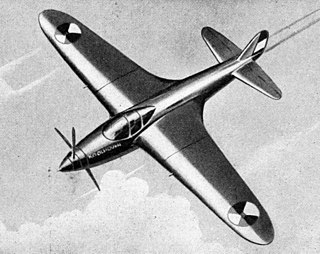
The Koolhoven F.K.55 was a Dutch fighter prototype of the 1930s, which did not progress beyond the prototype stage.

The BAT F.K.25 Basilisk was a prototype British fighter aircraft of the First World War. A single engined biplane intended to meet a requirement to replace the Sopwith Snipe, the Basilisk was unsuccessful, only three being built.

The RWD-11 was a six-passenger feeder-liner designed and built in Poland from 1932.
The Koolhoven F.K.57 was a twin-engined, gull-winged monoplane built in the Netherlands as a personal transport for the Director General of Royal Dutch Shell. Only one was made, flying chiefly in Europe in the year before World War II, but destroyed when Germany invaded the Netherlands in May 1940.

The Barnhart Twin 15 "Wampus-Kat" is a twin engine biplane that was built in 1920.

The NVI F.K.35 or Koolhoven F.K.35 was a two-seat fighter aircraft built in the Netherlands during 1926. It was completed and exhibited but, through a combination of ground accident and financial problems, never flown.

















